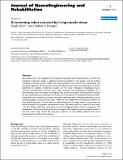| dc.contributor.author | Dennis, Robert G. | |
| dc.contributor.author | Herr, Hugh M | |
| dc.date.accessioned | 2010-09-29T19:04:25Z | |
| dc.date.available | 2010-09-29T19:04:25Z | |
| dc.date.issued | 2004-10 | |
| dc.date.submitted | 2004-09 | |
| dc.identifier.issn | 1743-0003 | |
| dc.identifier.uri | http://hdl.handle.net/1721.1/58765 | |
| dc.description.abstract | Biomechatronics is the integration of biological components with artificial devices, in which the biological component confers a significant functional capability to the system, and the artificial component provides specific cellular and tissue interfaces that promote the maintenance and functional adaptation of the biological component. Based upon functional performance, muscle is potentially an excellent mechanical actuator, but the larger challenge of developing muscle-actuated, biomechatronic devices poses many scientific and engineering challenges. As a demonstratory proof of concept, we designed, built, and characterized a swimming robot actuated by two explanted frog semitendinosus muscles and controlled by an embedded microcontroller. Using open loop stimulation protocols, the robot performed basic swimming maneuvers such as starting, stopping, turning (turning radius ~400 mm) and straight-line swimming (max speed >1/3 body lengths/second). A broad spectrum antibiotic/antimycotic ringer solution surrounded the muscle actuators for long term maintenance, ex vivo. The robot swam for a total of 4 hours over a 42 hour lifespan (10% duty cycle) before its velocity degraded below 75% of its maximum. The development of functional biomechatronic prototypes with integrated musculoskeletal tissues is the first critical step toward the long term objective of controllable, adaptive and robust biomechatronic robots and prostheses. | en_US |
| dc.description.sponsorship | United States. Defense Advanced Research Projects Agency (DARPA #6890899) | en_US |
| dc.publisher | BioMed Central Ltd | en_US |
| dc.relation.isversionof | http://dx.doi.org/10.1186/1743-0003-1-6 | en_US |
| dc.rights | Creative Commons Attribution | en_US |
| dc.rights.uri | http://creativecommons.org/licenses/by/2.0 | en_US |
| dc.source | BioMed Central Ltd | en_US |
| dc.title | A swimming robot actuated by living muscle tissue | en_US |
| dc.type | Article | en_US |
| dc.identifier.citation | Journal of NeuroEngineering and Rehabilitation. 2004 Oct 28;1(1):6 | en_US |
| dc.contributor.department | Harvard University--MIT Division of Health Sciences and Technology | en_US |
| dc.contributor.department | Massachusetts Institute of Technology. Media Laboratory | en_US |
| dc.contributor.department | Program in Media Arts and Sciences (Massachusetts Institute of Technology) | en_US |
| dc.contributor.mitauthor | Herr, Hugh M. | |
| dc.relation.journal | Journal of NeuroEngineering and Rehabilitation | en_US |
| dc.eprint.version | Final published version | en_US |
| dc.identifier.pmid | 15679914 | |
| dc.type.uri | http://purl.org/eprint/type/JournalArticle | en_US |
| eprint.status | http://purl.org/eprint/status/PeerReviewed | en_US |
| dc.date.updated | 2010-09-03T16:22:36Z | |
| dc.language.rfc3066 | en | |
| dc.rights.holder | Herr et al.; licensee BioMed Central Ltd. | |
| dspace.orderedauthors | Herr, Hugh; Dennis, Robert G | en |
| dc.identifier.orcid | https://orcid.org/0000-0003-3169-1011 | |
| mit.license | PUBLISHER_CC | en_US |
| mit.metadata.status | Complete | |
